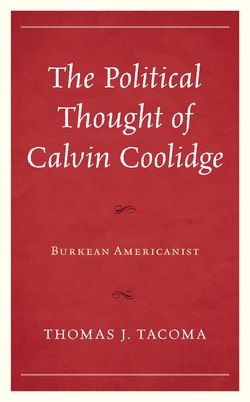Читать книгу The Political Thought of Calvin Coolidge - Thomas J. Tacoma - Страница 12
На сайте Литреса книга снята с продажи.
The Roots, Principles, and Achievements
of American Progressivism
ОглавлениеAmerican Progressives self-consciously rejected the principles and institutions of America’s founding regime. They did not hide this fact from the American public, although their language often presented their reforms as part of a trajectory of development and growth rather than revolution. The doctrines of universal human rights announced in the Declaration of Independence were replaced with contingent rights dependent upon time and place. The institutions of government created by the federal Constitution were criticized as insufficient for the needs of the new era, out of date, or as obstacles to further development.[1] In their place, key Progressives proposed new principles and new institutions that would allow for more organic political growth and greater flexibility of means and ends.[2] The goal of this chapter is to provide an overview of Progressive ideas and reforms in order to set Coolidge’s thought in the context of (and at times in contrast to) the Progressive movement. This chapter therefore aims (1) to identify the economic and cultural background of Progressivism, (2) to survey its philosophic background, (3) to describe the core principles that united Progressives of all kinds in their roles as political reformers and critics of the existing regime, and (4) briefly to enumerate some of the major political and legal reforms enacted during the Progressive era.
Before delving into the roots of Progressivism, however, some clarification of who and what is meant by “the Progressives” is in order. The Progressive movement as a movement lasted from roughly 1890 to 1920. Some scholars date the beginning of the movement earlier, back to 1880 or even 1870 and the movement then for civil service reform. Some also argue for extending the dates of the Progressive movement into the 1920s.[3] Whatever the date range, the years in between witnessed a searching investigation and debate over fundamental American ideas about government—over the meaning and propriety of republicanism, constitutionalism, democracy, and natural rights. Those doing the searching and debating were an initially loose coalition of political reformers who grew to recognize their shared principles and aims while they sought to transform American government at the national, state, and local levels. Their leadership ranks included the presidents of the era, Theodore Roosevelt and Woodrow Wilson in particular, though President Taft was unquestionably a moderate Progressive.[4] Numerous journalists and their muckraker colleagues were influential in the movement. Herbert Croly, Walter Lippmann, and lesser-known figures such as William Allen White played key roles in developing and popularizing Progressive ideas and reforms.[5] At the state level, various governors earned national recognition for their Progressive bona fides, including Robert La Follete of Wisconsin, Hiram Johnson of California, and Charles Evans Hughes of New York. Urban reform leaders, such as Jane Addams, legal minds such as Louis Brandeis and Ernst Freund, historians such as Charles Beard and Frederick Turner Jackson, and political scientists such as Frank Goodnow played a significant part in pressing for reforms in their respective spheres.[6] The Progressives were initially split between the major political parties, favoring the Republicans, but ultimately they formed a new political party in 1912 to support Roosevelt’s campaign for the presidency. The Progressive Bull Moose Party brought most of the outspoken Progressives together, and their Party Platform of 1912 provides a clear picture of what reforms they believed were still needed to fix the nation’s unresolved problems.[7] The institutional Progressive Party waned in strength in the 1910s and was all but gone by the early 1920s.
